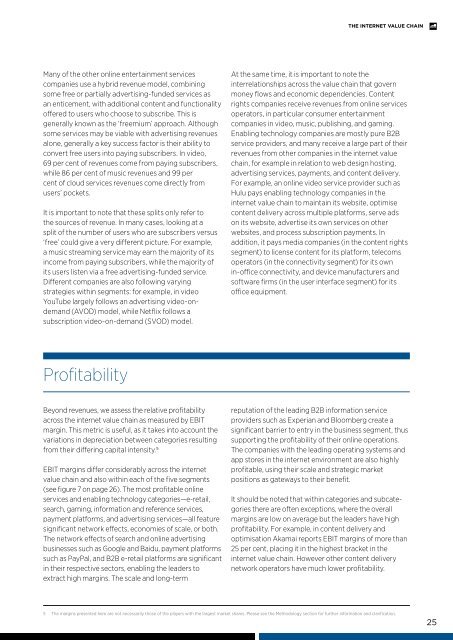The Internet Value Chain
GSMA_The-internet-Value-Chain_WEB
GSMA_The-internet-Value-Chain_WEB
Create successful ePaper yourself
Turn your PDF publications into a flip-book with our unique Google optimized e-Paper software.
THE INTERNET VALUE CHAIN<br />
Many of the other online entertainment services<br />
companies use a hybrid revenue model, combining<br />
some free or partially advertising-funded services as<br />
an enticement, with additional content and functionality<br />
offered to users who choose to subscribe. This is<br />
generally known as the ‘freemium’ approach. Although<br />
some services may be viable with advertising revenues<br />
alone, generally a key success factor is their ability to<br />
convert free users into paying subscribers. In video,<br />
69 per cent of revenues come from paying subscribers,<br />
while 86 per cent of music revenues and 99 per<br />
cent of cloud services revenues come directly from<br />
users’ pockets.<br />
It is important to note that these splits only refer to<br />
the sources of revenue. In many cases, looking at a<br />
split of the number of users who are subscribers versus<br />
‘free’ could give a very different picture. For example,<br />
a music streaming service may earn the majority of its<br />
income from paying subscribers, while the majority of<br />
its users listen via a free advertising-funded service.<br />
Different companies are also following varying<br />
strategies within segments: for example, in video<br />
YouTube largely follows an advertising video-ondemand<br />
(AVOD) model, while Netflix follows a<br />
subscription video-on-demand (SVOD) model.<br />
At the same time, it is important to note the<br />
interrelationships across the value chain that govern<br />
money flows and economic dependencies. Content<br />
rights companies receive revenues from online services<br />
operators, in particular consumer entertainment<br />
companies in video, music, publishing, and gaming.<br />
Enabling technology companies are mostly pure B2B<br />
service providers, and many receive a large part of their<br />
revenues from other companies in the internet value<br />
chain, for example in relation to web design hosting,<br />
advertising services, payments, and content delivery.<br />
For example, an online video service provider such as<br />
Hulu pays enabling technology companies in the<br />
internet value chain to maintain its website, optimise<br />
content delivery across multiple platforms, serve ads<br />
on its website, advertise its own services on other<br />
websites, and process subscription payments. In<br />
addition, it pays media companies (in the content rights<br />
segment) to license content for its platform, telecoms<br />
operators (in the connectivity segment) for its own<br />
in-office connectivity, and device manufacturers and<br />
software firms (in the user interface segment) for its<br />
office equipment.<br />
Profitability<br />
Beyond revenues, we assess the relative profitability<br />
across the internet value chain as measured by EBIT<br />
margin. This metric is useful, as it takes into account the<br />
variations in depreciation between categories resulting<br />
from their differing capital intensity.5<br />
EBIT margins differ considerably across the internet<br />
value chain and also within each of the five segments<br />
(see figure 7 on page 26). <strong>The</strong> most profitable online<br />
services and enabling technology categories—e-retail,<br />
search, gaming, information and reference services,<br />
payment platforms, and advertising services—all feature<br />
significant network effects, economies of scale, or both.<br />
<strong>The</strong> network effects of search and online advertising<br />
businesses such as Google and Baidu, payment platforms<br />
such as PayPal, and B2B e-retail platforms are significant<br />
in their respective sectors, enabling the leaders to<br />
extract high margins. <strong>The</strong> scale and long-term<br />
reputation of the leading B2B information service<br />
providers such as Experian and Bloomberg create a<br />
significant barrier to entry in the business segment, thus<br />
supporting the profitability of their online operations.<br />
<strong>The</strong> companies with the leading operating systems and<br />
app stores in the internet environment are also highly<br />
profitable, using their scale and strategic market<br />
positions as gateways to their benefit.<br />
It should be noted that within categories and subcategories<br />
there are often exceptions, where the overall<br />
margins are low on average but the leaders have high<br />
profitability. For example, in content delivery and<br />
optimisation Akamai reports EBIT margins of more than<br />
25 per cent, placing it in the highest bracket in the<br />
internet value chain. However other content delivery<br />
network operators have much lower profitability.<br />
5 <strong>The</strong> margins presented here are not necessarily those of the players with the largest market shares. Please see the Methodology section for further information and clarification.<br />
25


